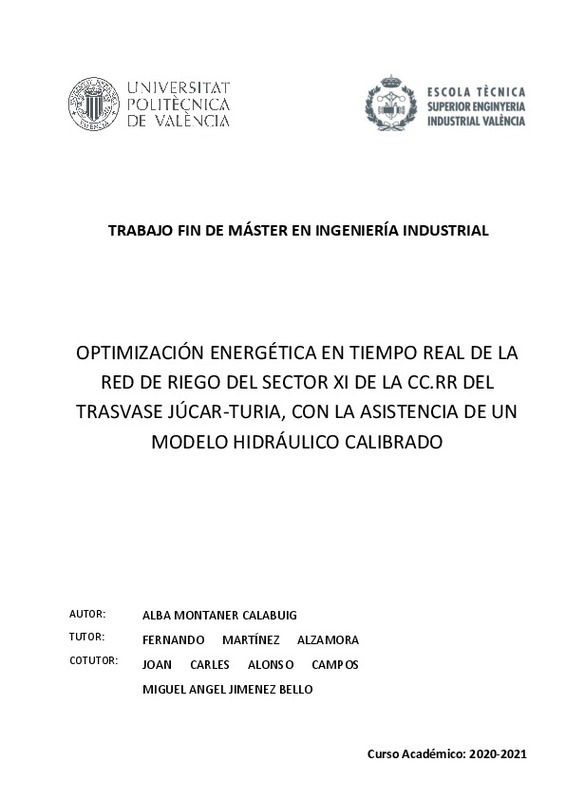|
Resumen:
|
[ES] Tradicionalmente, el riego por superficie ha ido asociado al establecimiento de unos turnos de riego en los cuales el regante podía hacer uso del agua suministrada. Fuera de esos turnos no tenía permitido utilizarla. ...[+]
[ES] Tradicionalmente, el riego por superficie ha ido asociado al establecimiento de unos turnos de riego en los cuales el regante podía hacer uso del agua suministrada. Fuera de esos turnos no tenía permitido utilizarla. Con la llegada del riego presurizado, las comunidades de regantes pasaron a utilizar como alternativa la organización de riego a la demanda. En esta modalidad, el regante podría abrir el hidrante siempre que quisiera y durante el tiempo que creyese conveniente, estando únicamente limitado el caudal y el volumen consumido (Planells et al., 1999). Esta modalidad de riego a la demanda al agricultor tener un mayor grado de libertad a la hora de regar, cambiar de cultivos o extender las superficie de riego. Sin embargo, a cambio de esta mayor flexibilidad para la programación de los riegos, el coste económico correspondiente al trazado de la red se veía incrementado. Esta disyuntiva entre economía y flexibilidad nos lleva a plantearnos el trabajo comparativo presentado en este TFM.
El presente trabajo busca comparar, por una parte, el diferente comportamiento de las redes diseñadas a turnos a la demanda desde ambos puntos de vista: economía y flexibilidad. Para ello, se van a comparar los diseños de dos redes de riego: la red de riego de Molinar (Lapo Pauta, 2019) y la red de riego propuesta por Clement y Galand (Labye et al. 1988). Por otra parte, también se compararán dos métodos de diseño. El primero de los métodos que se llevará a cabo es el basado en la serie económica para redes ramificadas. Con este método se diseñarán ambas redes tanto para un diseño a la demanda como para el diseño basado en turnos.
Normalmente, en el diseño basado en el establecimiento de turnos de riego, se ha admitido que el diseño más eficiente es el que distribuye estos turnos de manera que la demanda satisfecha presenta la mínima desigualdad entre todos los turnos disponibles, es decir, la distribución de demandas que conduce a la mínima desviación típica. Esta tendencia se cuestionará al utilizar un método de diseño en el que un algoritmo genético buscará la mejor solución tanto para los diámetros de las conducciones como para la distribución de los turnos.
La última fase del trabajo se dedicará a comparar la flexibilidad de ambos diseños. El diseño a la demanda basado en la estimación de caudales mediante el método estadístico propuesto por Clèment incluye ya el concepto de garantía de suministro, que puede interpretarse como una medida de la flexibilidad. Se comprobarán los diseños basados en el riego a turnos para ver cuál es el comportamiento de la red en el caso de que estos turnos no sean respetados.
[-]
[EN] Traditionally, surface irrigation has been associated with the establishment of irrigation shifts in which the irrigator could make use of the supplied water. Outside of those shifts, he was not allowed to use it. ...[+]
[EN] Traditionally, surface irrigation has been associated with the establishment of irrigation shifts in which the irrigator could make use of the supplied water. Outside of those shifts, he was not allowed to use it. With the advent of pressurized irrigation, the irrigation communities began to use the organization of irrigation on demand as an alternative. In this mode, the irrigator could open the hydrant whenever he wanted and for as long as he deemed convenient, only the flow rate and the volume consumed being limited.
This modality of irrigation on demand allows the farmer to have a greater degree of freedom when it comes to watering, changing crops or extending the irrigation areas. However, in exchange for this greater flexibility in scheduling the irrigation, the economic cost corresponding to the layout of the network was increased. This trade-off between economy and flexibility leads us to consider the comparative work presented in this TFM.
The present work seeks to compare, on the one hand, the different behaviors of networks designed in shifts and on demand from both points of view: economy and flexibility. To do this, the designs of two irrigation networks will be compared: The Molinar irrigation network and the irrigation network proposed by Clément and Galand.
On the other hand, two design methods will also be compared. The first of the methods to be carried out is that based on the economic series for branched networks. With this method, both networks will be designed for both an on-demand design and a shift-based design.
Normally, in the design based on the establishment of irrigation shifts, it has been accepted that the most efficient design is the one that distributes these shifts in such a way that the satisfied demand presents the minimum inequality between all the available shifts, that is, the distribution of demands leading to the smallest standard deviation. This trend will be questioned when using a design method in which a genetic algorithm will find the best solution for both the pipe diameters and the distribution of shifts.
The last phase of the work will be devoted to comparing the flexibility of both designs. The design on demand based on the estimation of flows using the statistical method proposed by Clèment already includes the concept of guarantee of supply, which can be interpreted as a measure of flexibility. The designs based on irrigation in shifts will be checked to see what the behavior of the network is in the event that these shifts are not respected.
[-]
|




![[Cerrado]](/themes/UPV/images/candado.png)





